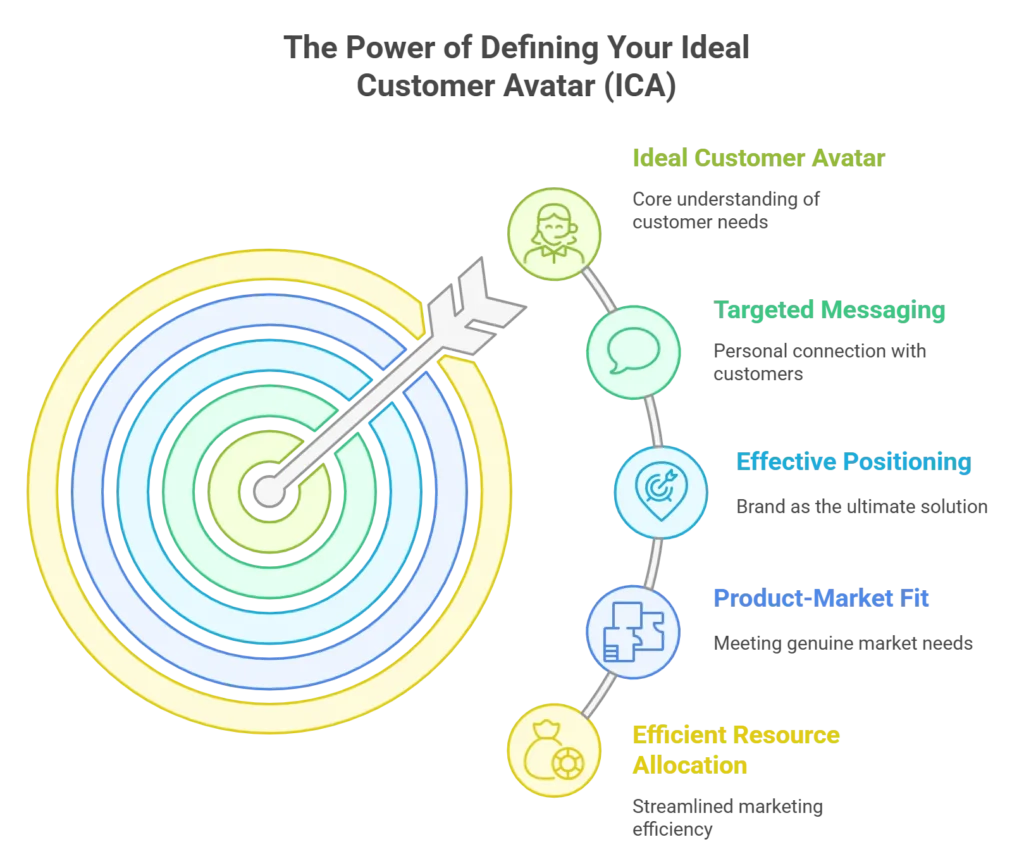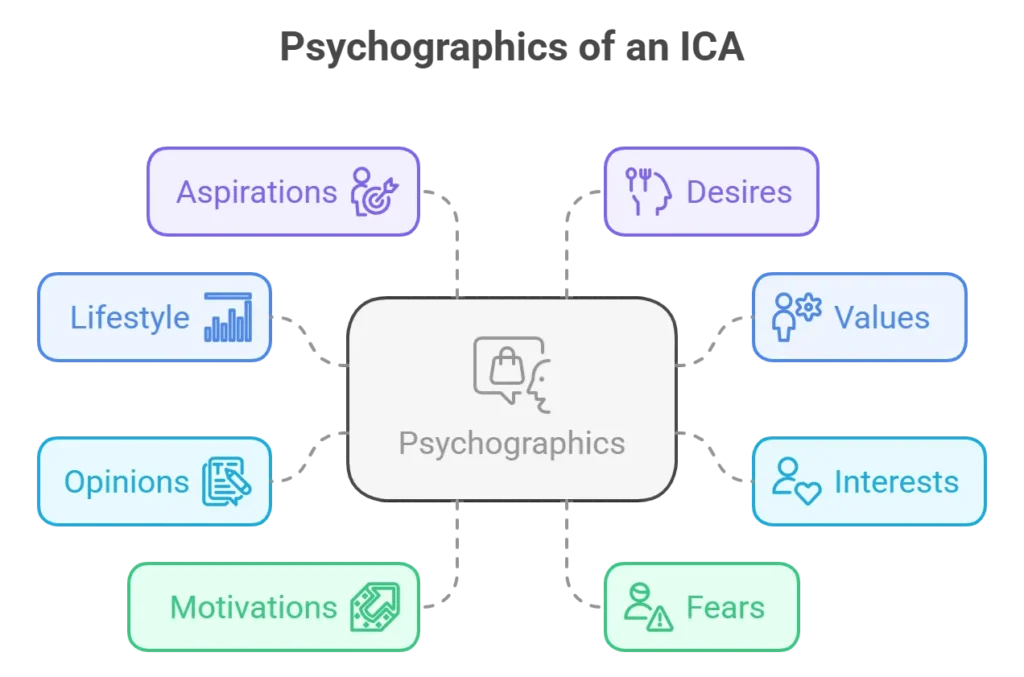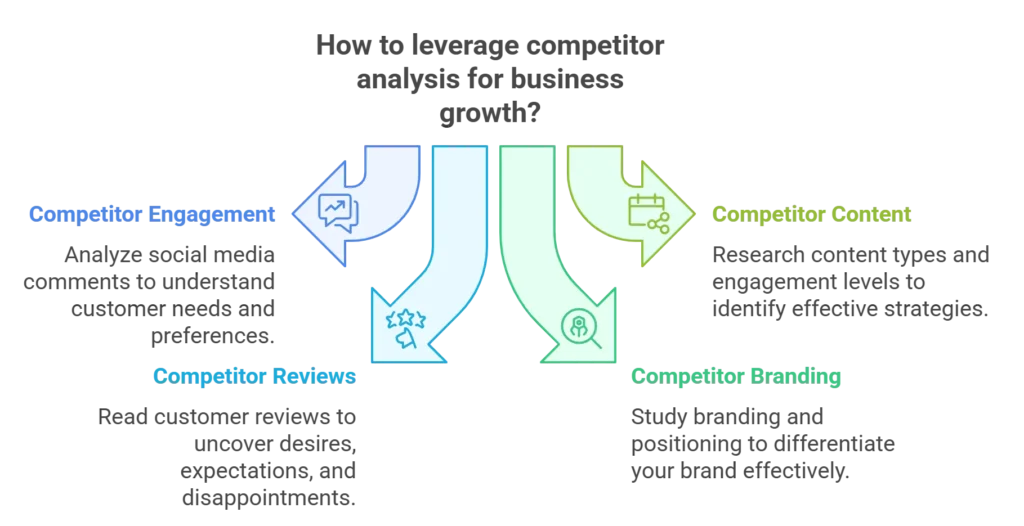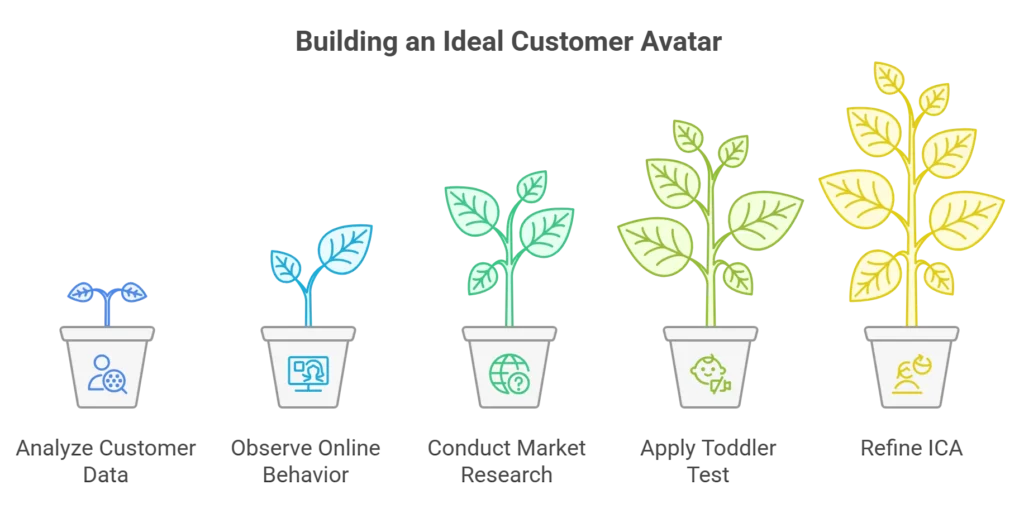How to Define Your Ideal Customer Avatar
The Definitive Guide to ICAs
Ever feel like your marketing messages are just shouting into the void? You’re crafting brilliant campaigns, but the right people just don’t seem to be listening? The secret to cutting through the noise isn’t louder volume; it’s laser-focused precision.
And that precision comes from truly, deeply understanding your Ideal Customer Avatar (ICA), also often referred to as “buyer persona”, “customer profile”, or similar.
An ICA is essentially a super-detailed, semi-fictional portrait of your perfect customer – the one who’ll not only buy from you but become a raving fan. Think of it as giving a name, a face, and a personality to the most important person in your business life.
And no, an ICA does not have to be a person – it can also be a business (I’m talking to you B2B guys and gals). The process of defining the persona is the same.
Why Your Business Needs an Ideal Customer Avatar
Let’s be brutally honest. Without a crystal-clear ICA, you’re flying blind. Whether you’re an established business that already has an existing customer base or you’re brand new to the stage, you’re going to want to define an ICA after reading this article. Trust me.
A deep understanding of your ICA isn’t just a “nice-to-have”; it’s the bedrock of all effective marketing. It’s the compass that guides every decision, ensuring your efforts hit the bullseye every single time – and I’m not exaggerating.
Here’s why it’s so mission-critical:
1. Targeted Messaging That Truly Connects
When you know your ICA intimately – their dreams, fears, the language they use, what makes them tick – you can craft messages that resonate on a personal level. You stop talking at them and start talking with them. The goal? To make them feel understood, not just to make them understand your offer. The key word here is “empathy”. And empathy builds likability.
2. Effective Positioning – Become THE Solution
Your ICA helps you define exactly who your brand is the ULTIMATE SOLUTION for. Without this clarity, you’re just another fish in the sea. With it, you can tailor your product or service to their specific needs and shout from the rooftops why you’re their perfect match.
3. Achieving Product-Market Fit (PMF) Like a Boss
Understanding your ICA ensures your product or service actually meets a genuine market need. You’re no longer just pushing a product; you’re offering a solution that fits your ideal customer like a custom-tailored suit. You focus on a market with a NEED, not just a product you hope someone wants.

4. Efficient Resource Allocation – No More Wasted Cash
Time, money, energy – all precious resources. Knowing exactly who you’re targeting means you can pour these resources into the channels and strategies most likely to reach and convert your ICA. Say goodbye to scattergun marketing and hello to streamlined efficiency!
5. Creating Irresistible Desire
Let’s face it, marketing perfection is about making your specific consumer avatar DESIRE your offer more than anyone else’s. A deep understanding of their motivations allows you to tap into their core wants and craft offers that they simply can’t refuse.
6. Building a Brand Identity That Sticks
Your ICA heavily influences your brand’s personality, voice, and values. When you know who you’re serving, you can build an identity that they connect with, fostering trust, loyalty, and a sense of belonging.
More on brand identity and archetypes in future articles – hang in there! In the meantime, here’s an article about all the ways you can create empathy through writing (clicking will open it in a new tab).
7. Content Creation That Captivates
No more guessing what content to create! Your ICA guides your content strategy, ensuring you produce entertaining, informative, and relevant material that grabs their attention and keeps them hooked. You’ll know what they want to hear, not just what you think they need to hear.
In essence, your ICA is the golden key. It unlocks smarter product development, sharper messaging, and a marketing strategy that actually works.

What Makes an Ideal Customer Avatar?
So, what exactly is this magical ICA? It’s more than just a list of demographics.
An Ideal Customer Avatar (ICA) is a detailed, semi-fictional representation of your perfect customer. It’s a vivid picture of an exact person who is most likely to purchase your product or service and, crucially, become a loyal, enthusiastic advocate for your brand.
Here’s what goes into a truly effective ICA:
Fits Your Serviceable Obtainable Market (SOM)
Your ICA isn’t a mythical creature. They must realistically fall within the segment of the market you can actually reach and serve – your serviceable obtainable market (SOM). This means considering practicalities like geographical limitations, their ability to purchase (demographics), and any technological requirements.
Embodies Key Characteristics (It’s More Than Just Age and Gender!)
A strong ICA is multi-dimensional:
- Demographics: The basic stats – age, gender, location, income, education.
- Sociographics: Their lifestyle, values, interests, and opinions. What do they care about?
- Behavioral Aspects: How do they buy? What are their brand preferences? How do they behave online and interact with content?
- Psychology: This is where the gold is. What are their core motivations, deep-seated pain points, hidden fears, and lofty aspirations? What do they truly desire? This requires moving beyond guesswork and actively learning about them.
Based on Solid Research and Cold, Hard Data
Creating an ICA isn’t a creative writing exercise. It involves digging into data about your existing customers (if you have them) to find common threads in their demographics, interests, and habits.
This real-world data makes your avatar “tangible”. You should also factor in insights from your ad viewers, social media followers, and website visitors.
A Tool for Laser-Focused Marketing
Defining your ICA allows you to speak to a SPECIFIC person. When you visualize this individual, you can tailor your marketing messages, content, and offers to resonate with their unique needs and desires. This focus is paramount to becoming the ultimate solution for your ideal customer.
Beyond Selling a Feeling (At Least Initially)
While building a strong brand identity that evokes emotion is a long-term goal, startups especially should initially focus on selling the product or service. Defining and targeting your ICA helps ground this initial focus on a concrete customer. Refine your brand positioning as you gather market insights.
Think of your ICA as the North Star for your marketing ship. It keeps you heading in the right direction, ensuring you don’t get lost in the vast ocean of seemingly “potential” customers. Trust me, that’s going to happen at some point – let’s just hope you notice it before it’s too late.
The Anatomy of an ICA
To build a robust and actionable ICA, you need to gather specific types of information. Think of yourself as a detective, piecing together clues to create a complete profile.
Remember, your ICA can also be a company or, when it comes to B2B, the key individual within the company you’re targeting. A company is (still – even with AI) always run by people who have profiles you can analyze.
Here are the key data points:
Demographics – The Who
These are the foundational statistical characteristics. Don’t just list them; understand how they impact their needs and purchasing power.

- Age: Not just a number, but what life stage are they in?
- Gender: How might this influence their preferences or needs?
- Location: Geographical limitations of your Serviceable Obtainable Market (SOM). If local, are they familiar with local references you might use?
- Income: Can they afford your offer? Are you targeting actual wealth or those who aspire to look upper class? Would they likely want to make use of “buy now pay later” solutions, for example?
- Education: What’s their educational background? What’s their reading level like?
- Ability to Purchase: Beyond income, do they have the authority or means to make the purchase?
Psychographics – The Why
This is where you delve into their inner world – their lifestyle, values, and mindset. This is often more revealing than demographics alone.

- Lifestyle: How do they live? What are their daily routines? Do they do anything that’s very characteristic of their type of person?
- Values: What principles guide their decisions? (Your brand positioning should align here.)
- Interests: What are their hobbies and passions? What are their search habits? What type of content do they like consuming online?
- Opinions: What are their viewpoints on relevant topics?
- Motivations: What truly drives them? Tap into their intrinsic motivation by considering autonomy, competence, and relatedness. What makes them WANT to do things?
- Fears: What are they afraid of losing? What anxieties keep them up at night? (Wouldn’t it be great if your offer could relieve them of those fears? More on this later…)
- Aspirations: What are their dreams? Do they long for freedom, or to become a version of themselves they’ve always envisioned? (Use aspirational copy!)
- What they truly desire: People ultimately care about what your product/service can do for them. Uncover their “wants,” which often trump their “needs.”
“Rather than relying solely on demographics, I place greater emphasis on psychographics—understanding what they value, fear, and what truly motivates their decisions. […] The result is a buyer persona that goes well beyond age, gender, or income—focusing instead on buying mindset, content preferences, goals, and pain points. […] Don’t stop at identifying who they are—dig deeper into what drives their buying behavior.”
-Sabah Drabu, CEO, CookinGenie
Technographics – The How (Online)
In today’s digital world, understanding their tech habits is crucial.

- Internet Connection: Essential if you’re selling online products or services.
- Gadget of Choice: Are they primarily on a computer, laptop, tablet, or mobile phone? This impacts your design and user experience.
- Online Behavior: Be aware that their stated preferences might differ from their actual online actions.
- Online Habits: How do they consume information online?
- Platforms They Use: Where do they spend their time online? (Social media, forums, online magazines, streaming services, etc.)
- Skill: How technologically savvy are they? Does your UI have to be super simple or would that likely seem like an insult to your very tech-savvy ICA?
“We go beyond basic demographic questions and delve into their daily routines, their challenges related to our product or service category, their goals, and where they seek information. For example, instead of just asking their age and job title, we might ask about a typical workday, the biggest frustrations they face in their role, what resources they trust for industry insights, and what motivates their purchasing decisions.”
-Shantanu Pandey, Founder & CEO, Tenet
Firmographics (Only for B2B)
For B2B Ideal Customer Avatars (ICAs), defining the “customer” extends beyond an individual to encompass the company itself and the various decision-makers within it.

Unlike a human (B2C) ICA which focuses solely on individual demographics and psychographics, a B2B ICA incorporates firmographics which are company-level statistics like:
- Industry: What kind of company are you targeting?
- Size: Are they small, mid-size, or large? How many people work there?
- Revenue: What is their estimated revenue and budget available (for your offer)? Define their purchasing power.
- Growth trends: Are they growing or are they looking to grow? If not, then why not?
When defining a B2B ICA, you should also look into the professional motivations, fears, and goals of key contacts:
- Job title: What is your key individual’s role withing your ideal target company? How many key individuals have the same (or similar) role?
- Department: In which department are they working and what (inter-personal) role do they play there in relation to other employees?
- Level of Authority: Can they make executive decisions relevant to your offer by themselves? If not, who else is involved?
This comprehensive approach ensures that marketing messages resonate not just with an individual’s personal needs, but also with the company’s culture, objectives, and operational challenges.
Your ICA in Relation to Your Offer
What is your ideal customer trying to achieve? What transformation are they seeking? What is it that your offer tries to help with?
Focus on the transformation they desire, not just the features and benefits you offer. Understand the outcomes they seek – how will their life be better after engaging with your product/service?
Understanding the goals and aspirations your ICA has and how relate to your offer is non-negotiable. Fail to define the link, and you’ve got a serious problem (that another offer could maybe help solve – I know a guy…)

Challenges & Pain Points – What Keeps Them Up at Night?
Understanding their problems is key to positioning your offer as the solution.
- Identify their pain points. Your marketing should skillfully agitate these before presenting your solution.
- Understand what they are going through. Any communication with your ICA should prove to them that you know their situation. Empathy is a powerful connector.
- Know what they dislike – what are their frustrations with current solutions (or lack thereof)?
- Identify their neglected needs. For instance, are they an above-average individual feeling under-challenged by generic offerings?
Watering Holes – Where Do They Hang Out?
Where can you find your ideal customer, both online and offline?
- Where does your community spend its time?
- Consider their online and search behavior – what are they typing into Google that’s related to your offer?
- Where are your existing ad and social media viewers and website visitors coming from?
- If you’re truly “in the scene” of your business, you should intuitively know many of these spots – likely because you’re spending time on them as well.
- Specific platforms like Reddit, Quora, and social media comment sections can be goldmines for information.
- Does your ICA consume mainstream media (TV, streaming services, magazines, newspapers)? Could you maybe reach them there?
What Sort of Communication Do They Respond Well to?
Apart from the classic consumer psychology principles – what sort of phrasing, wording, or “comportment” do they react favorable to? What type of actions on your end move them more towards “yes”?
- Do they prefer vague, open-ended phrasing or clear, concise instructions?
- Do they react better to positive oder negative framing?
- Do they like things to come easy, or do they prefer a challenge?
- Are they the serious type or do they enjoy humor? If so, what kind of humor?
- Do they prefer predictability oder unexpected twists?
- …
…the list goes on and is virtually endless. The key takeaway is that by asking yourself these questions and others like these, you can refine your messaging to fit your ICAs preferences.
Regardless of what their preferences are, your communications should always reflect them. This is non-negotiable if you want to make it rain online nowadays (so to speak).

Objections, Hesitations, and What They React Badly to
Anticipate and address the reasons why they might not buy and what sort of actions/communications on your end they could respond badly to.
- Consider what would make them doubt your offer.
- Think about their inherent skepticism. Why are they skeptical? What could change that?
- Proactively address common objections in your marketing materials.
- Sometimes, even telling people why they SHOULDN’T buy your product can build immense credibility and trust. This is a tactic called two-sided messaging. [link to article]
- Look at your list of what your ICA prefers. The opposite is likely what they’re going to react negatively to.
By diligently gathering and analyzing these data points, you move from a vague idea of your customer to a sharp, actionable Ideal Customer Avatar.
Knowling what your ICA reacts favorably or negatively to is a game-changer. Think about it: It automatically creates a set of guidelines for your future copy and creative for you.
ICA Research Methods That Work
“Assumption is the mother of all f*ck-ups.”
Wise words from the movie Under Siege 2
Alright, detective, it’s time to gather your intel! Creating a truly insightful ICA means rolling up your sleeves and doing some research. Guesswork is the enemy here.
You need to learn about your audience. Yes, even if you’re a brand new company starting out and haven’t had any sales yet.
Here are some tried-and-true methods:
Surveys & Interviews
The most direct route to understanding? Just ask! Literally.

Now, I know that this isn’t easy to do when you’re just starting out – you don’t have any customers yet, right? Then try interviewing people you know who experience the problems you’re trying to solve with your offer, for example. You’ll find a way.
The Power of Asking (Surveys)
Don’t underestimate the simple survey. Send short, focused surveys (5-6 questions is often plenty) to your existing customers or social media followers. Remember, you’re trying to find out what people want. Ask them open-ended questions where they’re likely to reveal details about their desires.
Pro Tip: Consider offering a small “thank you” or incentive for completing the survey. A little appreciation goes a long way!
Understanding Emotional State
Surveys and, more deeply, interviews can help you truly understand your audience’s emotional landscape – their motivations, fears, and aspirations. This is psychographic gold.
Use sentences like:
- If you could wave a magic wand and instantly improve one aspect of [relevant area], what would it be? (Identify problems)
- If you were to not find a good solution for [problem your product solves], what would be the potential negative impact for you? (Uncover fears)
- If [problem area] was completely solved for you, what would that enable you to do or achieve? (Define aspirations)
Refine surveys over time in an iterative process until the responses you receive include more revealing data.
Deeper Insights (Interviews)
Customer interviews allow for much richer, qualitative data. You can dig into their needs, desires, and even the exact language they use to describe their problems and goals. This provides invaluable context to quantitative data.
Interviews have the additional benefit that you can ask follow-up questions to zero in on the answers you’re looking for.
Observe Similar People Directly
“I once sat in a coffee shop and simply observed people who resembled my target audience, taking notes on how they dressed, what they talked about, and even how they interacted with their phones. That day, I realized how much body language and small talk reveal about priorities and frustrations-details you never get from a survey.”
-Erin Siemek, CEO, Forge Digital Marketing, LLC
Validating Assumptions
Got a hunch about your ideal customer? Use surveys and interviews to test those assumptions against reality. Never assume. Always test.
Social Listening & Analytics Review
The internet is a treasure trove of customer insights if you know where and how to look.

“I scour X and Reddit for unfiltered pain points, like safety concerns, which guide our content. […] My tip: Use analytics, surveys, and social chatter to build a vivid persona. Focus on values and pain points over basic stats. Test with small campaigns and adjust based on conversions. Keep iterating to stay sharp.”
-Chris Brewer, Managing Director, Best Retreats
Online Conversations Like Comments, Reviews, and Forum Discussions
Pay close attention to social media comments – not just on your own pages, but on your competitors’ too! These conversations are candid and can reveal unfiltered pain points, preferences, and the everyday language your ICA uses.
“Places like Amazon reviews, TikTok comments, and online forums give raw feedback that helps with messaging and positioning.”
-Josiah Roche, Fractional CMO, JRR Marketing
That’s right! Check out online content on your desired topic and read all sorts of comments from people experiencing problems, showing fears, or revealing aspirations.
Monitoring Brand Sentiment
While it can be trickier for smaller businesses, try to gauge the overall feeling around your brand and related topics online. If you spend enough time using regular “watering holes” your (potential) customers are using, you’ll catch the drift soon enough.
Understanding Audience Concerns and Preferences
Systematically monitor social media platforms to see what your audience is currently talking about (what’s trending?), worrying about, and getting excited about.
Look out for sentences like these:
- Okay, I’ve seen ten influencers post about [this topic]. I guess I should look into it if I want to [desired outcome]. (What’s currently trending?)
- The rising cost of [offer in your niche] is bothering me. Does anyone know of alternatives that will [desired outcome] for cheaper? (What are they worrying about?)
- Wow, I just heard of [gadget/service] that promises to make [pain point] effortless. Does anyone have experience using [gadget/service]? (What are they getting excited about?)
Analyzing Website Behavior (Analytics)
Tools like heatmaps and session recordings are your secret weapons. They show you exactly where people drop off in your funnel and what elements might be distracting or confusing them. This is direct insight into user behavior and potential pain points.
Tracking Digital Advertising Results
Modern ad platforms offer sophisticated tracking. This eliminates much of the guesswork by showing which marketing messages and audience segments are actually working.
Analyzing who engages with your ads and which phrasing in copy variations perform best can significantly refine your ICA.
Understanding Website Visitors
Dive into your website analytics. Who is visiting? Where are they coming from? What content do they engage with? This tells you who is currently interacting with your online presence and what type of content they prefer.
Pro Tip: If you can find out which search terms they entered to find your content, you can gain even more insight into their frustrations and desires. Google Search Console is phenomenal for this.
Ethical Competitor Audience Analysis
Your competitors can be an unwitting source of valuable information. Not to check their socials, blog posts, company reviews, and so on could almost be considered a waste, right?

Learning from Competitor Engagement
Look at the comments on your competitors’ social media. What are people asking for? What are they complaining about? What do they love? This can reveal what your own potential customers are looking for.
Researching Competitor Content
What types of content and topics are your competitors pushing? Which pieces get the most engagement (likes, comments, shares)? This gives you clues about their target audience’s interests and what resonates in your industry.
Read Competitor Reviews
Check the Google reviews your competitors have received. Real customers will sometimes pour out their hearts and souls into reviews – positive or negative. And the things you can learn about their desires, expectations, and disappointments are sometimes mind-boggling!
Pay attention to statements like these:
- The whole reason I chose [offer] was to [benefit received] so I could [achieve goal]. (Reveals desires)
- Given their reputation and the advertisement I saw, I was led me to believe that [desired outcome] was going to be [adjective]. (Shows expectations)
- The product felt flimsy and cheap [or other adjective], not at all like the [expectation] I was hoping for based on the reviews. (Reveals disappointments)
Analyzing Competitors’ Branding and Positioning
Study how your competitors are positioning themselves. Learn what to do and what not to do. This will help you ensure your own brand stands out and appeals specifically to your desired audience.
But be cautious with this one! Just because something is working, doesn’t mean there isn’t a way better approach. And copying another company’s brand identity and positioning is just going to make you the copycat.
Existing Customer Data & More
Often, the richest data is already within your grasp. Sure, I know, you have to be an established company for this, so feel free to skip this section, if you’re in the process of starting a new venture.

Analyzing Existing Customer Data
This is paramount. Find the commonalities among your best, most loyal clients.
How do their characteristics pair with the interests, demographics, and habits of your ad viewers, social media engagers, and website visitors? Leverage this data to make your ICA as accurate as possible. Study their purchasing patterns and feedback.
“I reach out to current customers, closed-lost deals, and even warm prospects and ask open-ended questions like, “What made you start looking for a tool like ours?” or “What nearly stopped you from buying?”
The goal isn’t to fill a form. It’s to understand what they care about, how they describe their problems, and what motivates action. I jot down patterns in their words, not mine, because how they talk is how they search, decide, and share.”
-Julian Knox, Marketing & PR Coordinator, Web Search Optimisation
Observing Online and Search Behavior (Beyond What They Say)
Recognize that what customers say they like or dislike can sometimes be very different from their actual online and search behavior. Prioritize understanding both for a comprehensive view.
“The most useful insights come from watching what people do when they’re not being marketed to. What they search late at night. What frustrates them in one-star reviews.”
-Josiah Roche, Fractional CMO, JRR Marketing
General Market Research
Don’t let your understanding become static. Regularly update your knowledge of your target audience through broader market research. Remember, telling people what they should want to buy is hard. Finding out what they want to buy is easier. Search and ask the web for what your potential customers would want.
“I also review customer service logs and sales call transcripts to hear the language they use. The most valuable insight usually comes from behavior and intent, not just broad stats. From there, I shape a profile that guides messaging, offers, and platform targeting.”
-Dan Taylor, Partner, SALT.agency
The “Toddler Test” (Creative Evaluation)
This is a more unconventional tip, but it has its merits! If your marketing creative (like an ad visual) can capture the fleeting attention of a very young child, it might possess a broadly appealing, unexpected element that grabs attention. (Source: Building an ICA.docx)
By combining these research methods, you’ll move from a fuzzy outline to a sharply defined Ideal Customer Avatar. Remember, audience research isn’t a one-and-done task; it’s an ongoing process as markets, trends, and customer preferences evolve. Keep iterating!
Connecting Your Avatar to Real-World Marketing Strategy
Okay, so you’ve done your research and you have a beautifully detailed Ideal Customer Avatar. Now what? The real power of the ICA comes when you connect it directly to your marketing strategy. This is where the rubber meets the road. A great way to do this is by using simple “If-Then” logic.
Here are five examples of how this plays out:

1. IF your ICA’s primary pain point is feeling overwhelmed by complex solutions…
…THEN your content and product messaging should focus relentlessly on simplicity and ease of use. Highlight your “easy solution” and reassure them that you have a system designed to relieve them of uncertainty and decision fatigue.
Reasoning: You’re directly addressing their frustration. By emphasizing simplicity, you’re speaking their language and making the choice to go with you much easier. You become the helpful guide, not another source of complexity.
2. IF your ICA primarily uses LinkedIn for professional development and industry information…
…THEN you should prioritize creating and sharing LinkedIn articles and video content that offer unique insights, data, or expert commentary relevant to their industry. Position your brand as a thought leader on this platform.
Reasoning: This ensures you’re meeting your ICA where they already are and in a context where they’re receptive to valuable information. You cater to their growth goals and build credibility.
3. IF your ICA’s main goal is to achieve a specific, life-changing transformation (e.g., massive business growth, complete lifestyle overhaul)…
…THEN your marketing messages should vividly paint a picture of life after using your offer. Focus on the desirable benefits and the “probable future” they can achieve with your help.
Reasoning: People are driven by emotion. Showing them the desired outcome, taps into their aspirations and makes your offer far more compelling than a dry list of features.
4. IF a common objection from your ICA is the perception that your solution is too expensive…
…THEN consider employing price anchoring (presenting a higher reference price or value proposition before revealing your actual price) OR shift your messaging to intensely focus on the immense value, ROI, and long-term benefits your offering provides.
Reasoning: Anchoring can make your price seem more reasonable. Focusing on value reframes the conversation from cost to gain, directly addressing their financial concerns by highlighting what they achieve, not just what they spend.
5. IF your ICA is strongly motivated by social proof and tends to choose options that most people choose…
…THEN prominently display testimonials, glowing reviews, case studies, and indicators of popularity (like “Bestseller,” “Most Popular,” or “Customer Favorite”) on your landing pages, product pages, and in your marketing materials.
Reasoning: This leverages the psychological principle of conformity. If others like them have found value, they’re more likely to believe they will too. The “Most people choose” tactic simplifies their decision-making.
By systematically applying this “If-Then” thinking based on the rich details of your ICA, you ensure that every piece of your marketing strategy is targeted, resonant, and far more likely to achieve its objectives. Remember, your ICA isn’t a static document; as they evolve, so too should your strategic responses.
Full-Fledged Examples and Resulting Strategies
Theory is great, but seeing Ideal Customer Avatars in action is even better. Let’s bring this to life with two distinct ICA profiles, similar to the examples you’re familiar with, and explore how channel and messaging strategy would differ for each.
Ideal Customer Avatar 1: “Tech-Savvy Startup Founder – Sarah”
Avatar Anatomy: Sarah
Demographics: Female, 30-35 years old. Lives in a major metropolitan hub (think San Francisco, New York, London). Founder/CEO of a SaaS startup (10-50 employees). Likely holds a postgraduate degree. Income: $150,000+.

Psychographics: Highly ambitious, incredibly driven. Values efficiency and innovation above all else. An early adopter of new technology. Obsessed with business growth and scaling. Extremely time-conscious – every minute counts. Actively seeks solutions that provide a tangible competitive edge. Follows industry trends religiously. Values being perceived as knowledgeable, successful, and ahead of the curve.
Goals:
- To scale her startup rapidly and sustainably.
- To significantly increase revenue and market share.
- To build a formidable brand reputation.
- To optimize team productivity to the max.
- To consistently stay several steps ahead of her competitors.
Pain Points:
- Chronically limited time for in-depth marketing research.
- Feels overwhelmed by the sheer volume of information and tools available.
- Needs to demonstrate clear ROI for all marketing investments to her board or investors.
- Deeply concerned about making the wrong, costly technology choices.
Channel/Messaging Strategy for Sarah:
Channels:
LinkedIn: This is her digital playground. Focus on high-value thought leadership content, sharing unique industry insights, data-backed analyses, and engaging in relevant professional groups. Run highly targeted LinkedIn ads showcasing precisely how your solution helps SaaS startups scale and achieve specific, measurable KPIs.
Industry-Specific Blogs & Niche Publications: Guest blogging spots and strategically placed sponsored content to reach her where she actively seeks expert knowledge. Content must be in-depth, actionable, and provide genuine value.
Relevant Podcasts & Webinars: Sponsorships or, even better, speaking opportunities to position your brand as a go-to authority. Podcasts are gold because she can consume them while multitasking (which she does, constantly).
Twitter (X): Share concise, potent insights, quick tips, and engage in real-time industry conversations.
Short-Form Video (e.g., YouTube Shorts, targeted TikToks – more for awareness than direct conversion initially): Offer quick, actionable marketing or productivity hacks tailored to startup growth challenges.
Messaging:
Emphasize value, efficiency, and ROI in every communication. Use data-driven proof points, statistics, and case studies to clearly demonstrate how your solution has helped other similar startups achieve their ambitious goals.
- Highlight how your offer provides a distinct competitive edge and fosters a culture of innovation.
- Speak directly to her desire for unparalleled efficiency and seamless scalability.
- Position your brand as an undeniable authority and trusted partner in the startup ecosystem.
- Use language that resonates with her aspirational identity as a visionary and successful founder.
- Consider leveraging the APP formula (Agree, Promise, Preview) in ad copy to instantly connect with her pain points and concisely offer your solution.
Creative Psychological Deep Dive:
In your content, subtly refer to a close-knit, high-performing team as “family members” or a “tight-knit crew.” This can resonate with a founder who pours her life into her company.
Use imagery and settings in advertisements that reflect Sarah’s daily grind and aspirations: sleek shared office spaces, late-night laptop sessions fueled by good coffee, dynamic cityscapes.
Consider sharing sophisticated, perhaps slightly edgy (but always professional) memes or commentary about outdated business practices or non-tech-savvy approaches to subtly boost your brand’s likeability and “in-the-know” status.
Ideal Customer Avatar 2: “Budget-Conscious DIY Enthusiast – Mark”
Avatar Anatomy: Mark
Demographics: Male, 45-55 years old. Lives in a suburban area, likely owns his home. Works in a skilled trade, or perhaps mid-level management. Some college education. Income: $50,000 – $75,000. Married, possibly with two kids.

Psychographics: Eminently practical and resourceful. Genuinely enjoys solving problems himself and the satisfaction of a job well done. Values getting a good deal and is a savvy shopper. Researches purchases carefully, especially for tools or materials. Heavily influenced by peer reviews, testimonials, and practical recommendations. Wary of overly expensive or unnecessarily complex features – he wants utility and reliability.
Goals:
- To complete home improvement projects affordably and effectively.
- To find reliable, durable, and long-lasting products that won’t let him down.
- To learn new skills and expand his DIY capabilities.
- To feel a strong sense of accomplishment and pride in his work.
Pain Points:
- Operates with a limited budget for his projects.
- Gets incredibly frustrated by products that don’t live up to their marketing claims or break easily.
- Can be overwhelmed by overly complex instructions or jargon. Needs clear, straightforward information and guidance.
Channel/Messaging Strategy for Mark:
Channels:
YouTube: This is his university. How-to videos, detailed product demonstrations, practical comparisons, and project showcases are king. Content should clearly show the value, ease of use, and tangible benefits of your product, always with an eye on cost savings.
Facebook: Engage actively in relevant DIY, home improvement, and local community groups. Share user-generated content (with permission!). Run targeted Facebook ads focusing on affordability, durability, and reliability.
Online Forums & Communities (e.g., Reddit’s r/HomeImprovement, specific trade forums): Participate genuinely in discussions. Answer questions, offer helpful advice related to his interests, and build a reputation as a helpful expert.
Email Marketing: Share practical project tips, new skill tutorials, inspirational project ideas, and exclusive deals or bundles for subscribers.
Blog: Create informative articles, step-by-step guides, and troubleshooting resources that directly answer his questions and provide solutions to common DIY challenges.
Local Hardware Store Partnerships / In-Store Demos (if applicable): If you have a physical product, being visible where he shops is key.
Consider traditional media like local radio or strategically placed billboard ads on his common commute to stay top-of-mind if your market is geographically concentrated.
Messaging:
Emphasize value for money and affordability at every turn. Clearly highlight how your product helps him achieve his project goals without breaking the bank. Focus on ease of use and practicality. Demonstrate how simple it is to use your product and the excellent, tangible results he can expect.
- Use compelling social proof like authentic testimonials (video is great!), before-and-after photos from other DIY enthusiasts, and customer reviews.
- Offer crystal-clear, specific instructions and readily available support (FAQs, simple diagrams, video tutorials).
- Frame your messaging around empowerment and accomplishment (“You can easily…”, “Achieve professional results yourself…”).
- Consider using value-based pricing and highlighting the long-term cost savings of choosing a quality, durable product.
- Tell stories of people just like Mark. Make him see himself and his own struggles by using expert storytelling.
Creative Psychological Deep Dive:
Appeal to his desire to be perceived as a capable, hard-working, and a good provider/dad. Use phrases like “the pride of a job well done,” “built to last, just like your commitment,” or “every homeowner’s trusted companion.”
Connect with his “inner grunt worker” – show that you understand and respect the value of hands-on work. Use straightforward, no-nonsense language. Phrases like “it’s a tough job, but this makes it easier” can resonate.
Acknowledge a common frustration: “We know many tools and materials today just don’t cut it or are overpriced.” This can trigger a “yes-reaction” from Mark, making your brand instantly more likable and relatable because you get him.
Understanding the Connection
By truly understanding the unique DNA of each Ideal Customer Avatar – their demographics, their inner world, their goals, and their frustrations – you can stop guessing and start connecting.
Tailor your channels, craft your messaging, and watch your marketing effectiveness soar. This is only truly possible with very clearly defined ICAs.
The TL;DR on ICAs – Your Quick Guide to Customer Clarity
Phew, now that was a deep dive! Let’s bring it all home with a quick recap of why Ideal Customer Avatars are your marketing best friend and how to get started.
What is an ICA?
It’s a detailed, semi-fictional representation of your perfect customer – the exact person most likely to buy from you and love your brand. It’s about visualizing a specific individual.
Why is it so crucial? Because it allows you to:
- Craft targeted messages that resonate deeply.
- Position your brand as the ultimate solution for them.
- Achieve product-market fit by meeting a real need.
- Allocate your resources efficiently, saving time and money.
- Create genuine desire for your offer.
- Build a brand identity they connect with.
- Develop content they actually want to consume.
What key data should you collect?
- Demographics: Age, gender, location, income, education.
- Psychographics: Lifestyle, values, interests, motivations, fears, aspirations.
- Technographics: Online behavior, preferred platforms, device usage.
- Goals: What are they trying to achieve? What transformation do they seek?
- Challenges/Pains: What problems are they facing? What keeps them up at night?
- Watering Holes: Where do they spend their time (online and offline)?
- Buying Motivators: What influences their decision to purchase? (Emotions, social proof, scarcity, value, etc.)
- Objections: Why might they hesitate to buy?
How do you research your ICA?
- Surveys & Interviews: Ask your existing customers and target audience.
- Social Listening: Monitor conversations on social media and forums.
- Analytics Review: Analyze your website, ad, and social media data.
- Competitor Audience Analysis: See who your competitors are attracting and how.
- Analyze Existing Customer Data: Find commonalities among your best customers.
How do you use it?
Connect your ICA insights directly to your marketing strategy using “If-Then” logic. Tailor your channels, messaging, content, and offers to their specific profile. Use examples like Sarah and Mark to find inspiration on different strategic approaches.
Some Inspiring Words
Creating and utilizing an Ideal Customer Avatar isn’t just another marketing task to tick off a list. It’s a fundamental shift in how you approach your entire business.
It’s about moving from “broadcasting to a crowd” to having a meaningful conversation with the right person. It’s about empathy, understanding, and ultimately, building stronger relationships that drive real results.
So, go forth, define your avatar, and watch your marketing transform from a hopeful shot in the dark to a well-aimed arrow hitting the bullseye, every single time. You’ve got this!






